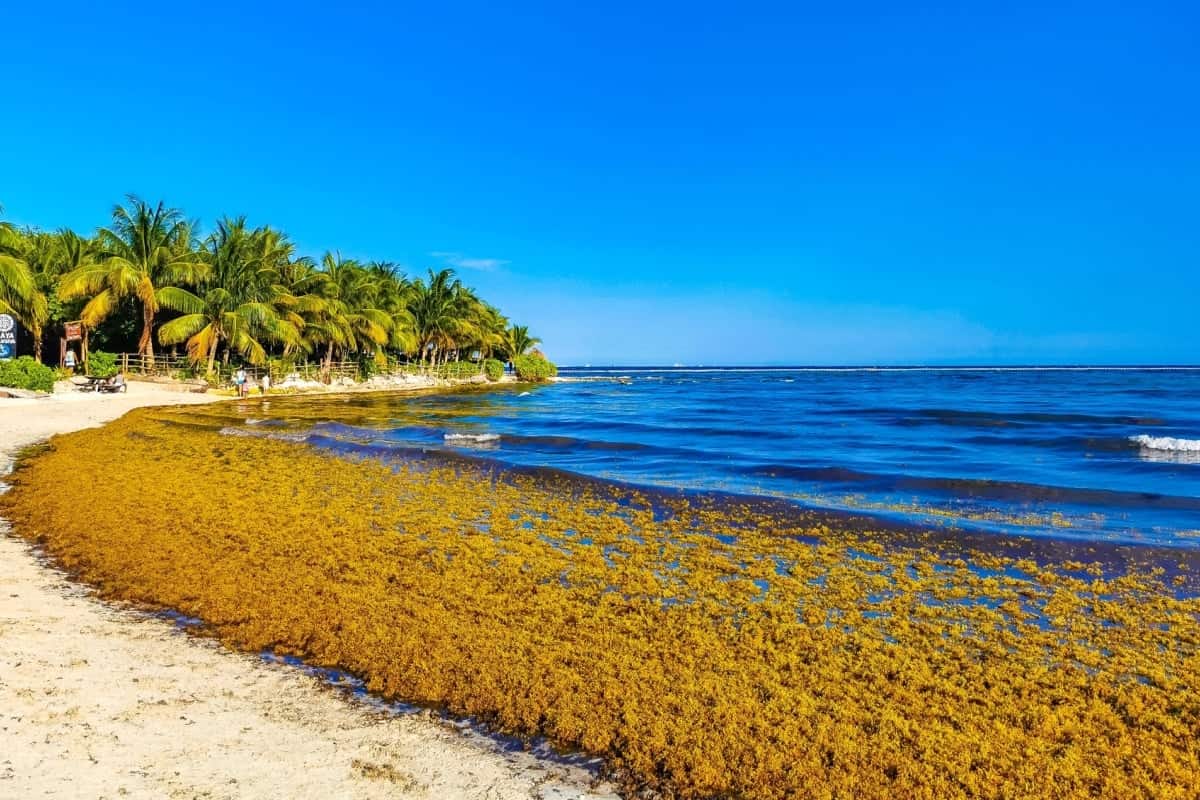Sargassum is a huge problem for many travelers during the summer months.
It ruins otherwise pristine white sand beaches, it smells terrible, and it can even stop you from being able to swim in the ocean.
Definitely not what you want on your dream beach vacation!
Worried that sargassum might affect your next trip? I’ve got bad news! The largest sargassum invasion in years is on its way.
Here’s what you need to know:
A Huge Sargassum Invasion Is Coming
A press release from the Sargazo Monitoring Network of Quintana Roo has revealed that an incredible and overwhelming sargassum mass is currently floating in the Honduran caribbean.

This mass is currently a whopping 5,000 km squared in size. That’s about 10 times the length of Cozumel Island.
And the bad news is that dominant east-west winds mean that this mass will reach the waters of the Mexican Caribbean in the coming weeks.
This is one of the biggest sargassum masses that the region has experienced in years.

The Director of the Sargazo Monitoring Network reported that between 200 and 300 thousand tons of sargassum are expected to arrive on the coast of the Mexican Caribbean this summer.
That’s a considerable amount more than the same coastline has experienced for the past couple of years.
Which Regions Will Be Impacted By This Sargassum?
The 6 regions that will be impacted by this incredible sargassum invasion are:
- The Mexican Caribbean Coast
- The Dominican Republic
- Jamaica
- The Lesser Antillean Arch Islands
- The Turks and Caicos Islands
- The Miami area in the Florida Peninsula, USA
All of these regions will be worst impacted during the summer months.

June, July, and August are expected to be the months when the most sargassum will land and the result will be devastated beaches across the board.
Why Is Sargassum Bad News?
Sargassum seaweed is a naturally occurring brown algae that blooms in the Atlantic Ocean each year.
It provides a home for sealife and other organisms, and is vital for the ecosystem of the ocean.
But it’s not such good news for tourists.
Although sargassum isn’t dangerous as a general rule, it ruins the appearance of normally pristine beaches.
When it reaches the shore and lands on these beaches, a couple of days under the hot sun means that it starts to smell too and begins to rot. Rotting sargassum produces hydrogen sulfide.
At this point, sargassum can become dangerous. Hydrogen sulfide can cause respiratory problems in people who are sensitive to it.

Because of this, as well as the animals and microorganisms that can live in sargassum, it’s best not to touch it. Especially with bare hands.
How Are Affected Destinations Dealing With Sargassum?
Many Mexican Caribbean destinations, including Cancun and Tulum, have installed sargassum barriers to stop the seaweed from reaching the shores.
These barriers don’t completely eliminate the problem and sargassum will still wash up on the shoreline, but they do help to reduce the amount.

Aside from these barriers, the most common way that destinations such as Mexico, Jamaica, and the Dominican Republic deal with sargassum is simply to remove it.
A job that’s easier said than done!
Dredge pumps, tractors, and the manual work of dedicated teams who lift the sargassum by hand using rakes and wheelbarrows all help to remove as much sargassum as possible.
If you’re staying in a resort with a private beach then you may also find that your resort has a dedicated team of staff who will clean up their beaches as quickly as possible.
Many resort beaches are piled high with sargassum first thing in the morning, but are useable by resort guests in the afternoon.

A top tip?
If you’re planning a vacation to one of the 6 destinations listed above where the sargassum is expected to be significant this year, then make sure your resort or hotel offers a pool as well as beach access.
That way, you’ll have somewhere to relax and unwind if the beach isn’t as clean as you might like it to be.
Credit: Source link

